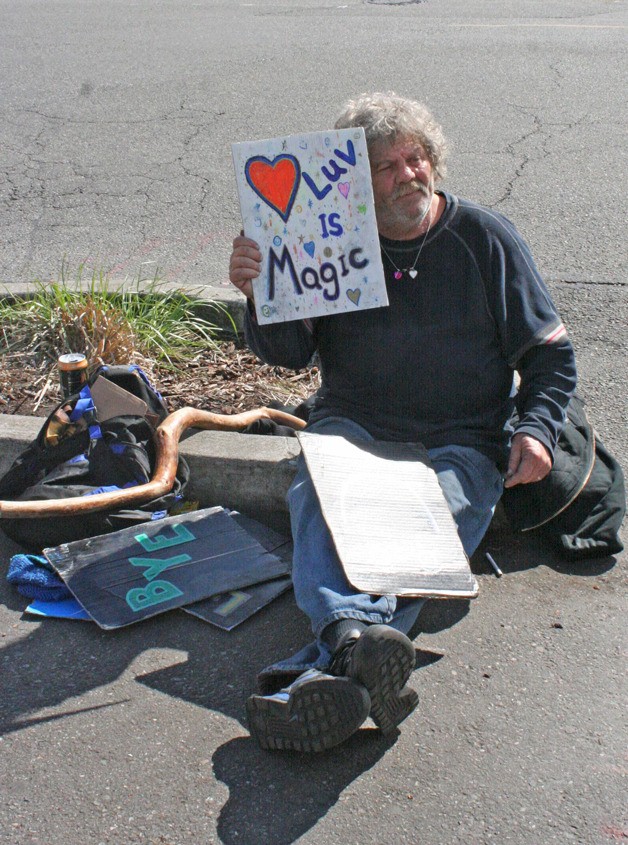On the street, Ray Conger is known as “The Mailman.”
Someone driving by the Safeway parking lot entrance might recognize him as the guy who holds up signs with messages like, “I love you” and “smile.”
“I tried holding a ‘help’ sign but it just didn’t feel right,” Conger said.
Conger has been homeless for two years, he said, and stays in his truck with his girlfriend.
He said he worked 20 years for the U.S. Postal Service and bragged he once had a high credit score and a 401k.
“I’m a broken person now,” Conger said.
Conger is part of a homeless population that more than doubled around 2012 and stayed that way.
The annual point-in-time count, conducted in January, is a state Department of Commerce program that gauges the number of homeless statewide on a given day.
In Island County, the count is led by the Opportunity Council with assistance from a few other agencies.
The official state count is expected to be released any day, but the unofficial count provided by the Opportunity Council shows that the county has roughly 90 people categorized as unsheltered, with 10 sheltered and another 150 who were staying with family or friends temporarily.
These numbers have remained relatively “static” over the past three years, according to Lisa Clark, director of the Opportunity Council’s Island County Service Center.
Clark said the jump three years ago could be due to a number of factors. Funding for a “rapid response” housing program ended in 2011, a program that helped the organization “reduce the incidence of homelessness” much quicker.
In addition, the county is seeing more new faces.
“There’s been an influx of people who haven’t been here over the last few years,” Clark said.
Clark and others who work with the homeless sense that the groups of homeless folks are moving slowly from community to community seeking services.
Whatever the reason, the numbers are dramatically higher than prior to 2012 when the unsheltered homeless number hovered around 40 or less.
“Homelessness is a complex issue anyway, there are a lot of layers,” Clark said. “If they have mental health or substance abuse issues, it adds to the complication.”
Clark stressed that the point-in-time count cannot by its nature be completely accurate. The count lies within a wide range of possibilities depending on the weather and how a homeless person categorizes their situation.
“It’s like a snapshot,” Clark said. “We’re not capturing everyone.”
Because the closest homeless shelter is in Mount Vernon, Whidbey Island’s homeless sleep in cars, live in the woods or float among other people’s homes, Clark said.
Tony Maggio, director of My Father’s House Community Thrift, offers free bag lunches to the local homeless population every Friday and Saturday.
Maggio visits a common encampment for the homeless, known as “the jungle,” which can be found in the Penn Cove area.
But Maggio said he’s seen the number of inhabitants there fluctuate from two up to 12.
“It’s gotta be hard to get an accurate count,” Maggio said.
Maggio said he agrees that the number of homeless he’s seeing on the island has increased over the last few years and that they run out of bag lunches every weekend.
“There’s no shortage of need,” he said.
Because of its lack of affordable housing, South Whidbey is particularly challenging for those trying to get back on their feet, Clark said. The Opportunity Council, which has offices in Oak Harbor five days a week, shares office space with Helping Hand of South Whidbey in Langley on Tuesdays to provide outreach services.
“It’s harder and harder to live on South Whidbey if you’re low income,” Clark said.
Once the official homeless count numbers are released, the human services department will present them to the Island County Board of Commissioners for consideration.
Commissioner Jill Johnson said she disagrees with the count’s inclusion of people “doubling up” and staying with others.
“It over-inflates the story of Island County’s homeless needs,” Johnson said. “I take a pretty narrow definition of homelessness. One of the conversations Island County needs to have is what definition do we use when we fund.”
Johnson said it might be a misperception that housing is an entitlement.
“I’m not sure I think it’s a basic human right,” Johnson said. “That’s a pretty expensive statement to make.”
Oak Harbor Police Chief Ed Green said Oak Harbor in particular had an increase in street population, but it’s tough to tell whether they are homeless or simply destitute.
“There are some new faces,” Green said, “which leads you to believe they are moving from place to place.”
Green, who worked as a police officer in Los Angeles, said that “any community that doesn’t have a shelter faces challenges.”
That said, “it doesn’t always mean they are going to use them,” he said.
“There’s no laws against being homeless.”
When asked if the island provides enough resources for the homeless, Conger flatly replied, “No.”
Conger said his survival has everything to do with the kindness of Oak Harbor residents and the community’s religious organizations.
“When I hit the corner, the people of Oak Harbor kept me fed,” Conger said.
Until Conger can raise enough money to get off the island and stay with friends, he said he must continue to panhandle while reminding people with his signs that “love is magic.”
“I think I’m supposed to be on the corner telling them I love them,” Conger said.



